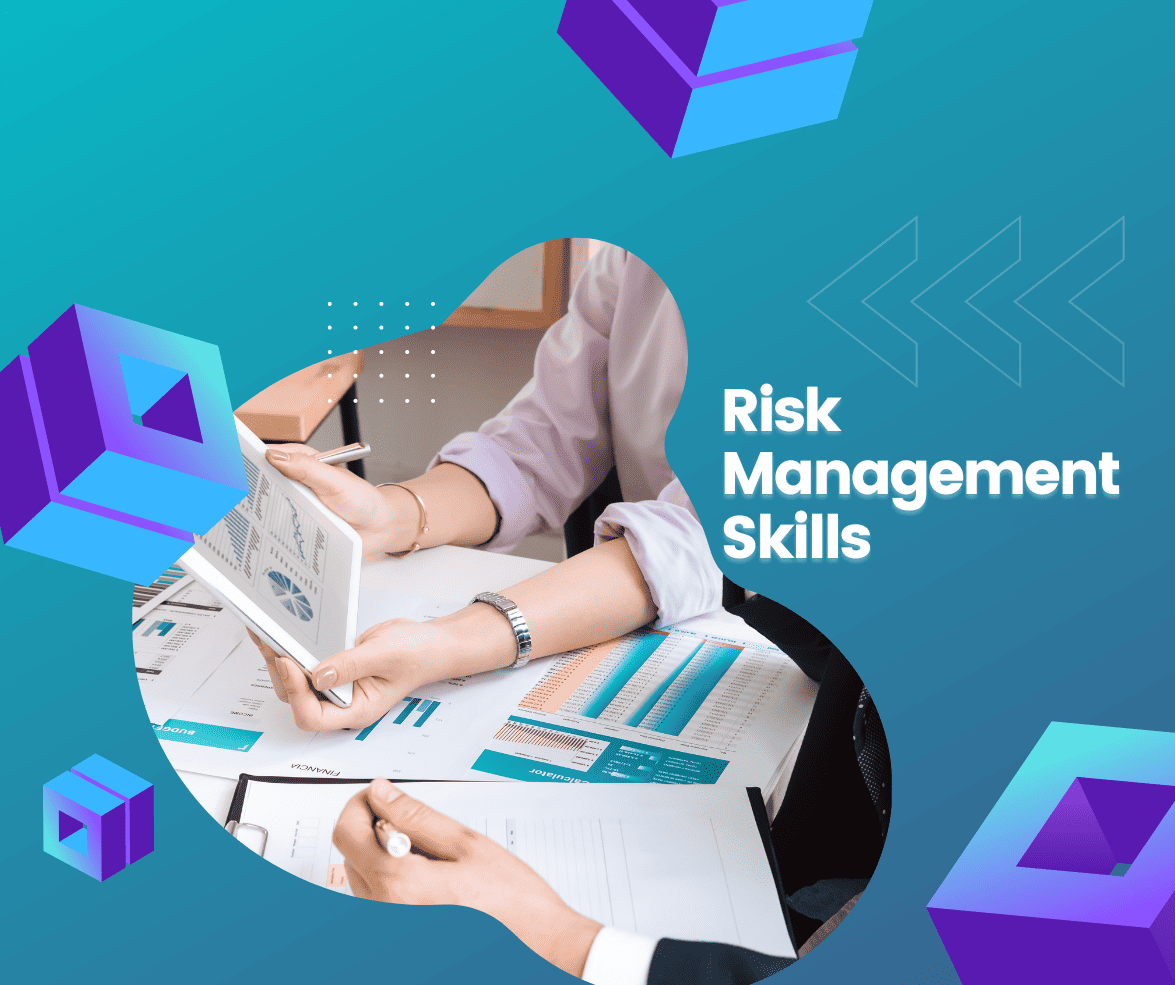Risk Management Skills
|
Getting your Trinity Audio player ready...
|
I. Introduction
A. Definition of risk management:
Risk management proactively identifies, evaluates and controls the potential disastrous effects that risks could have on an organization’s objectives. By developing strategies to minimize risk factors and implementing them with efficiency, organizations can make wise decisions while using resources optimally in ever-changing environments. Practicing comprehensive risk management is therefore key for any business looking to stay afloat amidst unexpected situations.
B. Importance of risk management in business:
1. Enhances decision-making: Risk management provides insights into potential threats and opportunities, allowing businesses to make informed decisions that minimize risks and maximize returns.
2. Reduces financial losses: By identifying and mitigating risks, businesses can minimize the financial impact of adverse events and protect their bottom line.
3. Improves operational efficiency: Implementing risk management processes helps organizations identify inefficiencies and weaknesses, leading to process improvements and cost savings.
4. Builds stakeholder confidence: A strong risk management framework demonstrates to investors, customers, and employees that the organization is prepared to handle uncertainties, increasing trust and credibility.
5. Ensures regulatory compliance: Risk management helps organizations identify and address potential compliance risks, avoiding legal penalties and reputational damage.
6. Fosters a resilient and adaptable organization: Businesses that actively manage risks are better positioned to respond to changes in the market, emerging threats, and new opportunities.
C. Purpose of the concise guide:
This efficient guide aims to give an overview of vital risk management principles, serving as a structure for comprehending and putting into practice successful risk management in any organization. It contains information on the framework for managing risks, tools used, duties and roles related to it, as well as strategies for drafting a thorough risk management plan and encouraging a culture that values safeguarding from potential threats. By adhering to the standards expressed within this short document, businesses can better maneuver unstable situations with confidence; protect their possessions whilst also achieving their goals.
II. Risk management process
A. Risk identification:
1. Internal risks: These are risks originating from within the organization, such as operational inefficiencies, employee misconduct, inadequate technology, or financial mismanagement. Identifying internal risks involves analyzing the organization’s structure, processes, and resources.
2. External risks: These are risks that stem from external factors beyond the organization’s control, including market fluctuations, regulatory changes, natural disasters, or geopolitical events. Identifying external risks requires monitoring the organization’s operating environment and staying informed of emerging trends and developments.
B. Risk assessment:
1. Qualitative analysis: This approach uses expert judgment, historical data, and stakeholder input to assess the likelihood and impact of identified risks. It involves categorizing risks based on subjective criteria, such as low, medium, or high impact and likelihood.
2. Quantitative analysis: This approach uses statistical techniques, numerical data, and mathematical models to estimate the probability and potential consequences of risks. It provides more precise estimates of risk exposure and allows for better comparison and prioritization of risks.
C. Risk prioritization:
1. Impact and likelihood: Risks are prioritized based on their potential impact on the organization’s objectives and the likelihood of their occurrence. Higher priority is given to risks with a greater potential impact and a higher likelihood of occurrence.
2. Risk matrix: A risk matrix is a visual tool that plots risks on a grid based on their impact and likelihood. This helps organizations quickly identify and prioritize the most significant risks that require immediate attention and resources.
D. Risk mitigation strategies:
1. Risk avoidance: This strategy involves eliminating the risk entirely by not engaging in activities that give rise to it. This approach is most suitable for high-impact, high-likelihood risks but may not always be feasible or cost-effective.
2. Risk reduction: This strategy aims to minimize the likelihood and/or impact of a risk through preventive measures, such as process improvements, employee training, or technology upgrades. It is most appropriate for moderate risks that can be effectively managed.
3. Risk transfer: This strategy involves shifting the risk to a third party, such as through insurance, outsourcing, or contractual agreements. This approach is suitable for risks that the organization is not well-equipped to manage internally.
4. Risk acceptance: This strategy involves acknowledging the risk and accepting its potential consequences. This is typically chosen for low-impact, low-likelihood risks that do not warrant the cost or effort of mitigation.
E. Risk monitoring and review:
1. Key performance indicators (KPIs): KPIs are measurable metrics that track the effectiveness of risk management strategies and processes. They help organizations monitor progress, identify areas for improvement, and ensure that risk management efforts align with business objectives.
2. Continuous improvement: Risk management is an ongoing process that requires regular monitoring and review to stay effective. Organizations should periodically reassess their risk landscape, evaluate the success of their mitigation strategies, and make adjustments as needed to address emerging risks and changing circumstances.
III. Risk management tools and techniques
A. Risk registers:
Risk registers are vital for keeping organizations on track; these centralized repositories document all identified risks and their associated impacts, probabilities of occurring, mitigation strategies, and the parties responsible. By regularly updating the register with new risks or reevaluating existing ones into consideration, companies can stay on top of risk management in a timely manner – therefore allowing them to proactively manage any potential threats before they become too severe.
B. SWOT analysis:
SWOT analysis is an invaluable tool for businesses of all sizes that helps identify and manage both external and internal risk factors efficiently. Strengths are the positive attributes of your business, weaknesses are areas that need improvement – opportunities being potential growth points and threats indicating risks to be aware of. By critically appraising each element, organizations can take advantage of their strengths, minimize weaknessess, seize upon new possibilities as they arise while protecting against foreseeable dangers in the future.
C. Failure Modes and Effects Analysis (FMEA):
FMEA is a proven method utilized to discern potential breakdowns in processes, products, and systems. It requires identifying failure modes related to their causes and effects on the entire system or process. By arranging failure modes based upon their severity, probability of occurrence, and detectability rates organizations can concentrate on resolving the most dangerous risks while improving reliability and performance levels within operations.
D. Scenario analysis:
Scenario analysis is a proactive technique that examines possible events and their influence on an organization. Through this “what-if” approach, organizations are able to evaluate the potential risks and opportunities associated with uncertainties in markets, regulations, or technologies. This process allows them to be better prepared for any future risk, take advantage of new openings as they emerge, and formulate robust strategies for success into the future.
E. Risk management software:
Risk management software is a digital solution intended to assist companies in accurately identifying, evaluating, prioritizing, mitigating and monitoring risks.
These tools usually contain features such as workflow managing capabilities for organizing the risk process more efficiently; dashboards with analytics that provide insightful decision-making information; reports used for tracking progress on each risk item; and registers which help streamline the whole process of risk management.
By automating mundane tasks while consolidating all vital data into one platform – it’s possible to improve efficiency markedly across your organization when it comes to comprehensive risk management efforts.
IV. Risk management roles and responsibilities
A. Senior management:
Senior management is vital to establishing the risk management framework and defining an organization’s risk appetite. They not only allocate resources, but also provide strategic guidance in order to ensure that all decisions take into account potential risks. Furthermore, senior managers set a culture of openness when it comes to discussions on risk by stressing transparency, responsibility, and communication between all stakeholders involved.
B. Risk management team:
The risk management team, comprising of risk managers, analysts and subject matter experts alike is tasked with the responsibility to set up and maintain the risk management framework. Through careful assessment of existing risks as well as identifying newly emerging ones, they then decide on strategies that can be implemented in order to mitigate them; these strategies are also monitored for effectiveness over time. A unified approach towards handling risks across all departments within an organization is achieved only when stakeholders take part in this collaborative effort.
C. Employees:
It is the responsibility of every employee to adhere to risk management policies and procedures, report any risks they see or suspect, and take part in training programs. By promoting a culture of safety throughout the organization we can effectively recognize risks at all levels. Collectively, it is our duty to ensure that organizations are free from potential hazards.
D. Third-party partners:
Organizations must effectively manage the risks that third-party partners, such as suppliers, vendors, contractors and consultants, can bring. To do this they should clearly define expectations for their partners related to risk management practices by conducting due diligence; incorporating risk management clauses into contracts; and frequently monitoring and measuring how well those standards are being met. This will help ensure any associated risks are adequately addressed.
V. Developing a risk management plan
A. Risk management policy:
A risk management policy provides the organization with a clear-cut method for recognizing, examining, and controlling risks. It serves as an effective foundation to our risk management framework – laying out objectives that clearly explain how we plan on managing our potential risks while remaining devoted to upholding the company’s core values. Our policy should be concise and easy-to-understand by all stakeholders involved in order to guarantee successful implementation of this strategy.
B. Risk appetite and tolerance:
Determining an organization’s risk appetite and tolerance is essential for success as it allows decision-makers to make informed choices regarding risk management. Risk appetite indicates the level of danger that a company is willing to endure in order to meet its goals, while risk tolerance identifies individual risks or categories of risks that are acceptable within certain boundaries. It’s integral for representatives from all levels of the business entity to frequently review these limits and adjust them accordingly depending on new scenarios or priorities.
C. Identification of risk owners:
Risk managers are people or teams who have a duty to oversee particular risks in the firm. Assigning risk ownership guarantees that dangers are adequately watched and handled, and accountability is assigned clearly. Risk owners must possess appropriate authority, resources, and know-how to manage their designated threats while being responsible for their outcomes.
D. Risk response plans:
Risk response plans outline the specific actions and strategies that will be employed to address identified risks. These plans should detail the mitigation measures, resources required, timelines, and milestones for each risk, as well as any contingency plans in case the initial response proves insufficient. Developing comprehensive risk response plans helps the organization proactively address risks and minimize their potential impact on operations and objectives.
E. Communication and reporting:
Risk management cannot be successful without efficient communication and reporting. Organizations should create transparent pathways for risk notifications, making sure that significant stakeholders are informed of the situation and taking part in this process. Regularly informing people regarding any potential risks, mitigation methods applied, as well as performance results is essential to ensure visibility while developing trustworthiness and encouraging wise decisions on all levels. To guarantee the reliability of those procedures it’s mandatory to evaluate them periodically to verify their efficiency and relevance.
VI. Implementing and maintaining a risk management culture
A. Training and awareness programs:
Establishing and facilitating training programs is essential for creating a strong risk management culture within the company. These courses should provide employees with information about the significance of risk management, the organization’s policies and procedures regarding it, as well as their individual roles in this process. Regularly updating these lessons can nurture an overall mindset that considers risks while staying up-to-date with recent trends and best practices.
B. Encourage open communication:
Establishing an open dialogue is essential for successful risk management. Organizations must cultivate a setting where employees feel safe to discuss risks, voice concerns and address problems without any worries of repercussions. This can be done by supporting a non-judgmental reporting culture, rewarding personnel who support the risk management process and highlighting the advantages of being transparent and working together in managing risks.
C. Learn from past mistakes:
By embracing the culture of continuous growth and learning, organizations can reduce risk and become more agile. Establishing a proactive approach to managing risks includes analyzing past errors or failures, discovering root causes, and taking corrective measures to prevent similar events in the future. This empowers organizations with an opportunity for better preparedness towards potential threats while making them less exposed to inconsistencies stemming from unanticipated circumstances.
D. Regular risk assessments:
A thriving risk management culture depends on thorough and regular assessments of any potential issues. Not only are these examinations key to keeping organizations knowledgeable about the latest risks, but they also review existing programs for reducing threats and uncovering new problems or changes within known ones. Such reviews highlight an organization’s commitment to mitigating hazards, creating a proactive attitude that is embraced by personnel as well as external stakeholders alike.
VII. Conclusion
A. Benefits of effective risk management:
Implementing a thorough risk management program can provide organizations with immense benefits, such as augmented decision-making capabilities, fewer monetary losses, greater operational efficiency and effectiveness, bolstered stakeholder faith in the company’s abilities, and higher regulatory compliance. Strategically managing risks enables corporations to protect their resources while staying stable even when faced with uncertain conditions – ultimately leading them closer to achieving their long-term goals!
B. Continuous improvement and adaptation:
Embracing a culture of continuous improvement is integral to any effective risk management strategy. Organizations must continuously monitor and review their risks while evaluating the efficacy of their mitigation strategies, as well as adjust where needed in order to remain agile and robust even when faced with uncertainty. By regularly reassessing their risk landscape, organizations can ensure they are prepared for any potential disruptions that may arise.
C. Importance of a proactive approach to risk management:
By taking a proactive stance towards risk management, organizations can quickly preempt and confront risks before they have time to occur. This smart strategy will not only reduce the likelihood of any potential dangers, but it will also create a stronger framework for development. Additionally, by integrating risk management into decision-making procedures and encouraging an informed culture surrounding risk awareness, businesses can confidently venture in uncertain waters while exploiting opportunities that lead to sustained success over long periods!








